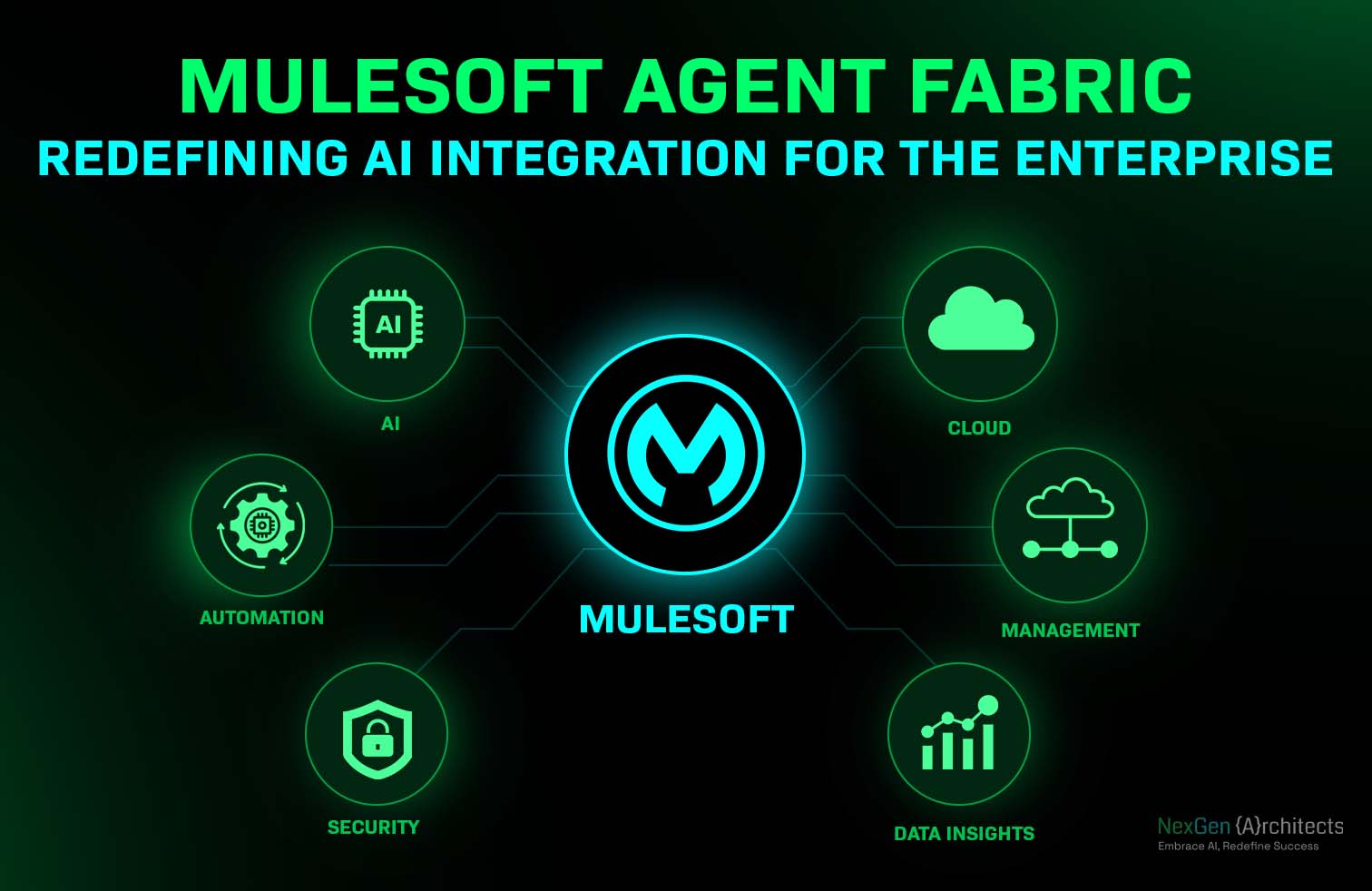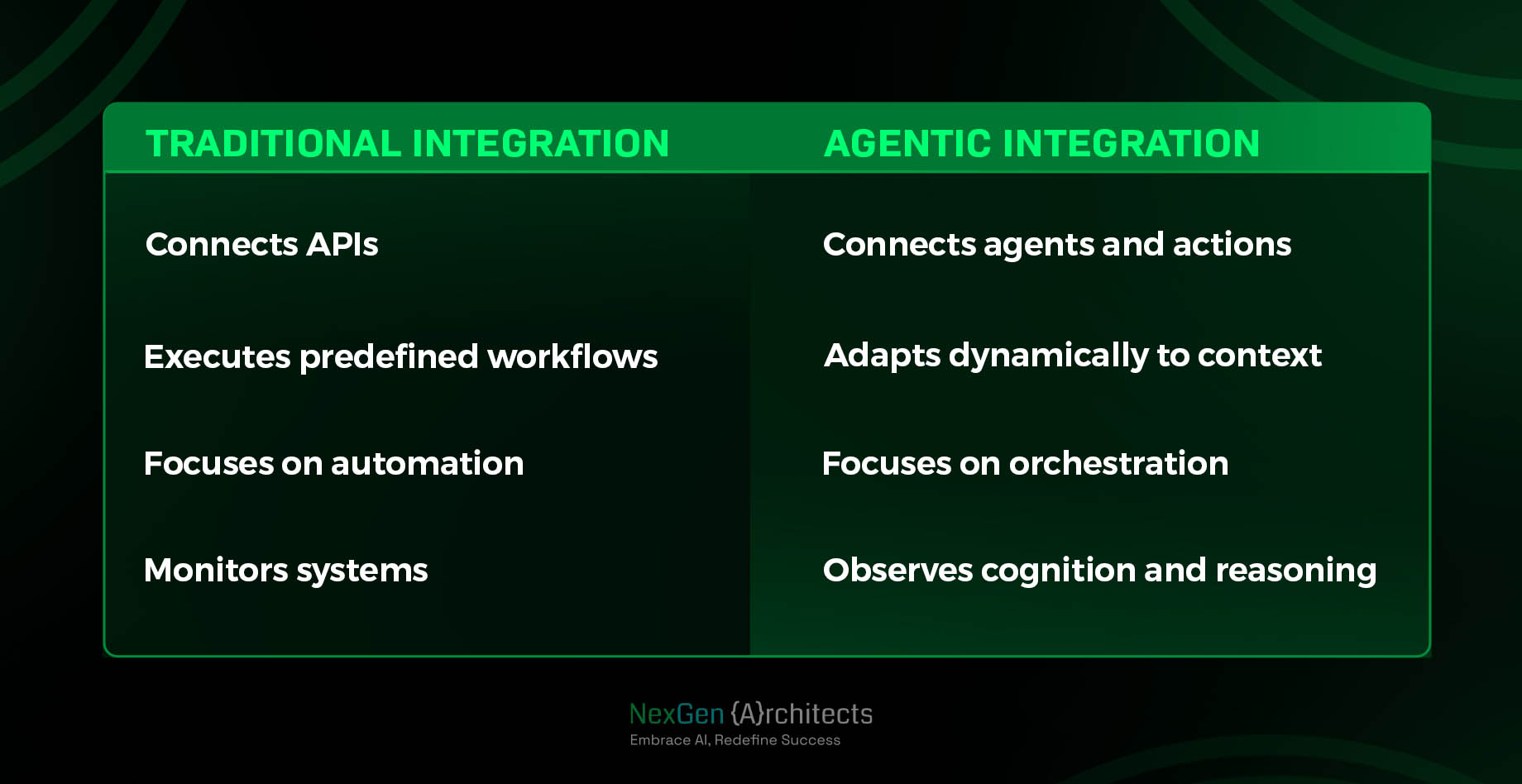How MuleSoft Agent Fabric Redefines Integration for the AI Era
What is MuleSoft Agent Fabric, how it unifies, governs, and orchestrates AI agents transforming fragmented automations into secure & intelligent enterprise networks.

For the past two decades, integration has meant connecting systems. But in the AI era, the goal has shifted. Now it’s about connecting intelligence.
Across every industry, companies are deploying hundreds of AI agents to analyze, decide, and act in real time. These agents power automation, personalization, and decision-making at a scale that humans alone could never achieve. But as each department builds its own bots and assistants, enterprises are facing a new and costly challenge: agent sprawl. Agent sprawl refers to the uncontrolled growth of disconnected, redundant, and unmanaged AI agents that act independently without centralized governance.
This fragmentation makes it difficult for enterprises to maintain visibility, enforce policies, or ensure that agents work toward shared business objectives. What starts as innovation quickly turns into chaos.
Salesforce MuleSoft Agent Fabric solves this problem by introducing a connective intelligence layer that unifies, secures, and governs all AI agents across the enterprise. It transforms fragmented automations into a coordinated, high-performing network, ensuring that every agent, regardless of where it was built, operates within a single governed ecosystem.
What Is MuleSoft Agent Fabric?
MuleSoft Agent Fabric is a Salesforce platform that manages and orchestrates AI agents, transforming a collection of fragmented agents into a unified, secure, and governed "Agentic Enterprise".
It’s not merely an integration tool. It’s the nervous system of the Agentic Enterprise enabling AI agents built anywhere to collaborate, communicate, and execute business processes safely and intelligently.
With Agent Fabric, organizations can:
- Discover every agent and tool through a centralized registry.
- Orchestrate workflows across different domains and systems.
- Govern every interaction through enterprise-grade policies.
- Observe and visualize the complete agent network in real time.
Instead of managing isolated bots, companies can now operate a coordinated ecosystem of intelligent agents all connected through a governed, secure, and observable fabric.
Problem It Solves: Agent Sprawl
AI has made it easier than ever to build an agent. The harder part is managing hundreds of them.
Different teams create their own agents, one for finance, one for support, one for logistics, each working well in isolation but completely disconnected from others. The result is fragmented intelligence: duplicated effort, security blind spots, and inconsistent results.
MuleSoft Agent Fabric addresses this head-on by introducing a single, governed platform where agents can be discovered, orchestrated, and observed. It ensures that enterprises maintain full control and visibility as their AI ecosystem scales.
Four Pillars of MuleSoft Agent Fabric
1. Agent Registry: Centralized Discovery and Reuse
The Agent Registry acts as a single source of truth for all AI assets whether they’re built internally, embedded in SaaS applications, or sourced externally. Teams can discover, reuse, and compose agents just like APIs in Anypoint Exchange, reducing duplication and accelerating innovation.
2. Agent Broker: Intelligent Orchestration
At the core of Agent Fabric is the Agent Broker, a smart routing engine that dynamically connects the right agents to the right tasks.
Built on open protocols like A2A (Agent-to-Agent) and MCP (Model Context Protocol), it enables complex multi-step workflows such as a mortgage approval or a logistics rerouting to execute seamlessly across domains.
3. Agent Governance: Enterprise-Grade Security and Compliance
Powered by MuleSoft Flex Gateway, Agent Governance enforces guardrails for every interaction.
It automatically applies policies for data protection, privacy, and compliance (including PII detection) across all agent communications ensuring AI adoption remains responsible and auditable.
4. Agent Visualizer: End-to-End Observability
The Agent Visualizer provides a live, visual map of the enterprise’s entire agent network.
It shows how agents interact, where bottlenecks occur, and even confidence scores for decisions. This transparency turns “black-box AI” into a trustworthy, explainable system that IT and business leaders can rely on.
From Integration to Orchestrated Intelligence
Traditional integration was about connecting applications. Agent fabric evolves this into connecting autonomous intelligence.

By embedding orchestration, governance, and observability directly into the integration layer, MuleSoft transforms from a connectivity platform into an intelligence platform.
This redefinition is what enables enterprises to scale AI safely and effectively.
Real-World Use Cases of MuleSoft Agent Fabric
To understand the real impact of MuleSoft Agent Fabric, it’s important to see how it transforms complex enterprise workflows into orchestrated intelligence. These are not hypothetical scenarios they represent how enterprises across industries are already using the platform to make AI truly operational.
1. Mortgage Processing: Turning Fragmented Tasks into a Seamless Flow
In financial services, processes like mortgage approvals are often riddled with disjointed systems, one for credit verification, another for compliance checks, another for document handling. Each system requires manual handoffs and validations that can stretch decision cycles from hours to days.
With MuleSoft Agent Fabric, this entire process can be automated and governed through intelligent agent orchestration.
Here’s how it plays out:
When a customer submits a mortgage application, a Mortgage Assistant Agent initiates the workflow. This agent doesn’t work in isolation it collaborates with other specialized agents:
- A Credit Check Agent performs real-time credit validation by accessing financial data sources securely.
- A Compliance Agent verifies the application against regulatory policies to ensure adherence to KYC and data-privacy rules.
- A DocuSign IAM Agent handles secure e-signature verification for the approval documents.
All of these agents communicate through the Agent Broker, which intelligently routes the workflow, ensuring that data flows securely through each stage.
The result? A process that once took several days can now complete within minutes with full auditability, compliance, and visibility through the Agent Visualizer.
This is cognitive orchestration, agents working together with awareness of context and rules.
2. Supply Chain Optimization: Achieving Real-Time Agility
Supply chains are highly dynamic systems where delays, inventory mismatches, and transportation disruptions can have cascading effects. Traditionally, resolving these issues requires multiple teams across logistics, ERP, and customer service systems to coordinate manually.
With MuleSoft Agent Fabric, these interdependencies are handled intelligently and in real time.
When an Operations Agent detects a potential shipping delay, say, due to weather or route congestion it automatically triggers a network of collaborating agents:
- The Fleet Management Agent recalculates optimal delivery routes.
- The ERP Agent updates the inventory and order management systems.
- A Customer Communication Agent notifies impacted customers and provides real-time delivery updates.
All of this happens autonomously through the Agent Broker, which ensures that agents act in sequence without human intervention.
Meanwhile, the Agent Visualizer provides a real-time map of all these interactions, showing which agents are active, where delays are minimized, and how workflows are adapting dynamically.
This level of agentic orchestration ensures enterprises can move from reactive supply chain management to predictive and proactive operations, improving efficiency, cost control, and customer experience.
3. Partner and Employee Onboarding: A New Standard for Compliance and Speed
Onboarding, whether for partners, vendors, or employees, typically involves multiple systems, departments, and approval chains. Access provisioning, account creation, and training assignment often occur in silos, creating friction and compliance risks.
MuleSoft Agent Fabric simplifies this by turning onboarding into an autonomous multi-agent workflow.
When a new partner is onboarded, a Partner Portal Agent orchestrates the following agents:
- A Sales Agent to generate and assign partner IDs.
- An IT Agent to provision credentials and access rights securely.
- A Knowledge Agent to recommend personalized enablement resources.
- A Compliance Agent to ensure all actions adhere to internal and external governance rules.
These agents operate in sync, coordinated through the Agent Broker, with Flex Gateway enforcing consistent security policies across every interaction.
For enterprises, the outcome is transformative, onboarding cycles are reduced from days to hours, compliance is automatic, and employees and partners begin operating productively from day one.
Why MuleSoft Agent Fabric Matters for the Enterprises
What these use cases have in common is not just efficiency; it’s intelligence at scale. MuleSoft Agent Fabric connects decisions, ensuring that every agent acts with the right context, under the right guardrails, and within a visible, auditable network.
Here’s what that means for modern enterprises:
- Decision Velocity
Agents act on real-time data from connected systems, enabling instant, contextual responses to changing business conditions.
- Compliance by Design
Every interaction is governed by enterprise and regulatory policies embedded directly into the Fabric.
- Operational Transparency
The Agent Visualizer gives IT and business leaders continuous oversight into how AI decisions are being made.
- Scalability and Interoperability
With standardized protocols like A2A and MCP, agents built on different platforms or languages can interoperate seamlessly.
By combining these capabilities, MuleSoft enables organizations to evolve from isolated automation into a governed, collaborative intelligence network.
Future: Building the Agentic Enterprise
Agentic Enterprise is the next evolution of digital transformation, one where humans and AI agents operate side-by-side as a coordinated digital workforce.
In this model, employees don’t just interact with dashboards or apps; they collaborate with agents that understand context, anticipate intent, and act autonomously all within enterprise-approved governance boundaries.
MuleSoft Agent Fabric turns this vision into reality. It transforms scattered, unmanaged automations into a connected intelligence fabric, enabling innovation that’s both scalable and secure.
Key Takeaways
- MuleSoft Agent Fabric is the foundation of the Agentic Enterprise, enabling unified governance and orchestration of all AI agents.
- It replaces fragmented automations with collaborative, context-aware intelligence.
- Its four pillars Registry, Broker, Governance, and Visualizer move integration from connectivity to cognition.
- By embedding security, observability, and interoperability, it allows organizations to scale AI responsibly and efficiently.
In a world where AI adoption is accelerating, the enterprises that succeed will be those who unify their agents into one governed, intelligent fabric. MuleSoft has already delivered the blueprint for that future.
If your organization is ready to move beyond automation and build a truly intelligent enterprise, now is the time to start exploring how it can make it real.

.svg)

